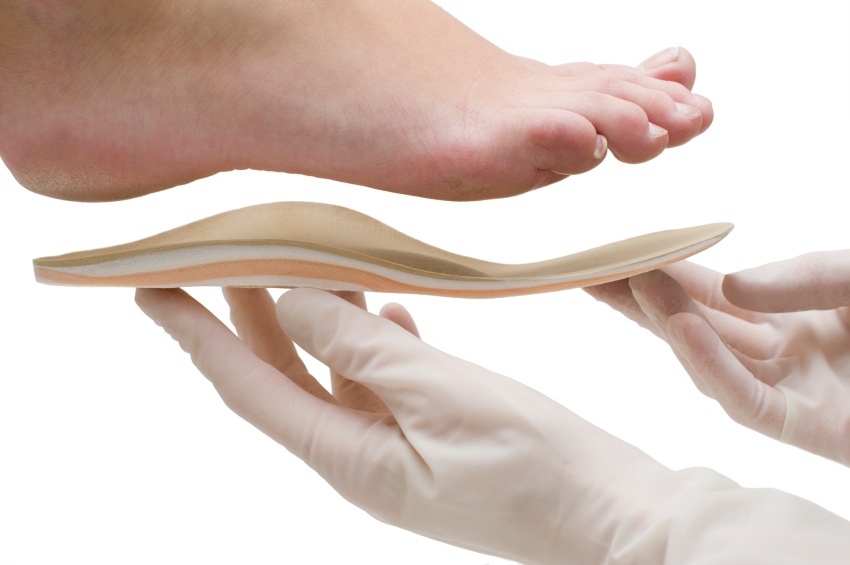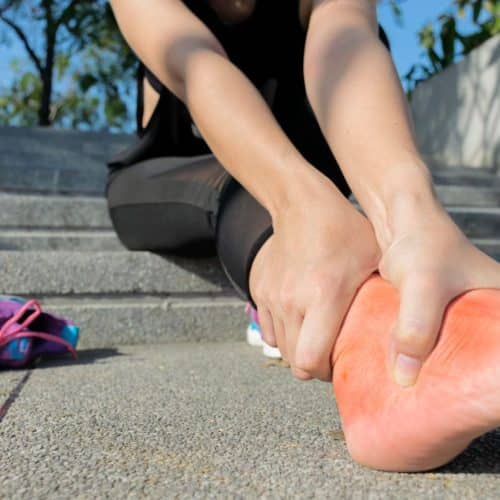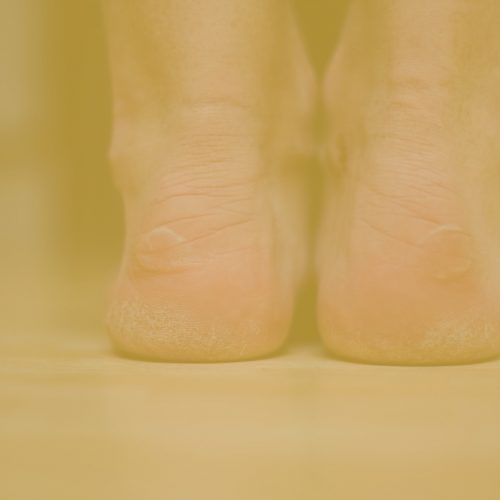Have you ever wondered how diabetes affects your feet? The connection might take time to be apparent, but it’s crucial to consider. Imagine a life where every step is accompanied by discomfort or even pain. This article delves into diabetes-related foot pain, offering valuable insights on prevention and treatment that can make a difference in your daily life.
Understanding the Diabetes-Foot Pain Link
Living with diabetes presents a unique set of challenges that extend beyond managing blood sugar levels. One aspect that deserves special attention is the connection between diabetes and foot pain. This link is rooted in the intricate interplay between high blood sugar levels, nerve damage, and compromised blood circulation.
1. The Impact of High Blood Sugar
Diabetes, especially when uncontrolled, leads to elevated levels of glucose in the blood. These high blood sugar levels can have far-reaching consequences, particularly for the nerves that transmit signals throughout the body. Nerves, much like electrical wires, are responsible for sending messages to the brain, allowing us to feel sensations like pain, heat, and cold. However, persistent high blood sugar can disrupt this process.
The nerves responsible for conveying sensations to the feet can suffer damage due to prolonged exposure to excess glucose. This condition, known as neuropathy, is a common complication of diabetes. Neuropathy impairs the nerves’ ability to transmit signals accurately, often leading to a reduced perception of sensations in the feet.
As a result, individuals may not feel pain when they sustain injuries or develop minor issues like blisters or calluses. This absence of pain sensation is dangerous, as it delays the recognition and treatment of potential foot problems.
2. Increased Risk of Infections
Another critical element of the diabetes-foot pain link lies in the compromised blood circulation that often accompanies diabetes. Blood vessels play a vital role in delivering oxygen and nutrients to different parts of the body, including the extremities. However, diabetes can cause the blood vessels to become narrower and less flexible, impeding the flow of blood to the feet.
This reduction in blood flow has significant implications. When an injury or wound occurs, the body’s natural defense mechanism relies on efficient blood circulation to deliver immune cells and healing factors to the affected area. In individuals with diabetes, the limited blood flow hampers the body’s ability to combat infections effectively.
Even minor cuts, scratches, or blisters can rapidly escalate into more severe infections, as the body struggles to mount a robust immune response. Consequently, individuals with diabetes face an increased risk of foot infections, which, if not treated promptly, can lead to serious complications and even amputation.
The link between diabetes and foot pain is multifaceted, involving both nerve damage and compromised blood circulation. It’s imperative for individuals with diabetes to understand these connections and take proactive measures to prevent and address foot problems.
Through proper diabetes management, consistent foot care, and regular medical check-ups, the risk of foot pain and related complications can be significantly reduced.
Preventive Measures for Foot Pain
When it comes to diabetes and foot health, prevention is key. Taking proactive steps to maintain the well-being of your feet can help you avoid potential complications down the road. Here are some comprehensive measures you can adopt to prevent foot pain and ensure your feet remain healthy:
1. Maintain Proper Blood Sugar Levels
Managing blood sugar levels is the cornerstone of diabetes care and significantly impacts foot health. Consistently high blood sugar levels can contribute to nerve damage and reduced blood circulation, increasing the risk of foot complications. By diligently monitoring your blood sugar levels, adhering to your prescribed medications, and adopting a diabetes-friendly diet, you can minimise the chances of neuropathy and other foot-related issues.
2. Develop a Daily Foot Care Routine
Establishing a daily foot care routine is paramount for maintaining healthy feet. Begin by inspecting your feet thoroughly for any signs of trouble. Look for cuts, blisters, redness, or swelling, paying close attention to areas that are often hidden, such as between the toes. Wash your feet gently with lukewarm water and a mild soap, then make sure to dry them meticulously, especially the spaces between your toes. Moisture can create a breeding ground for bacteria, so ensure your feet are completely dry before putting on socks and shoes.
3. Choose the Right Footwear
The shoes you wear play a pivotal role in preventing foot pain. Opt for footwear that offers both comfort and support. Look for shoes with a wide toe box to prevent friction and pressure points. Avoid shoes that are too tight, as they can cause rubbing and lead to blisters. High heels should also be avoided, as they can strain your feet and alter your gait. Instead, opt for shoes that provide cushioning and proper arch support to reduce the stress on your feet.
4. Engage in Regular Exercise
Physical activity is beneficial for overall health and can have a positive impact on foot health as well. Regular exercise improves blood circulation and helps control blood sugar levels, reducing the risk of complications. Activities like walking, swimming, and low-impact aerobics are excellent choices. Remember to wear well-fitting, supportive shoes while exercising to minimise the risk of injury.
5. Maintain Healthy Skin and Nails
Keeping your skin and nails in optimal condition is essential to foot care. Moisturise your feet regularly to prevent dry skin, but avoid applying lotion between your toes, as excess moisture can lead to fungal infections. Trim your toenails straight across and avoid cutting them too short to prevent ingrown toenails. If you have difficulty managing your nails, consider seeking assistance from a podiatrist.
Preventing foot pain in individuals with diabetes requires a combination of diligent self-care practices and proper podiatry management. You can significantly reduce the risk of foot-related complications by maintaining stable blood sugar levels, establishing a daily foot care routine, wearing appropriate footwear, staying physically active, and attending to skin and nail health.
Remember that your feet are valuable indicators of your overall health, and taking proactive measures to care for them will contribute to your well-being and quality of life.
Treating Foot Pain Effectively
Dealing with foot pain when you have diabetes requires a careful and proactive approach. If you experience discomfort, it’s essential to take action promptly to prevent the progression of issues and potential complications. Here are some effective strategies for treating foot pain and addressing related problems:
1. Consult a Healthcare Practitioner
If you’re experiencing persistent foot pain or notice any unusual changes in your feet, seeking professional medical advice is crucial. A healthcare practitioner with experience in diabetes care, such as a podiatrist or an endocrinologist, can accurately diagnose the underlying cause of your foot pain. They will assess your foot health, review your medical history, and determine an appropriate treatment plan tailored to your needs.
2. Medications for Pain Management
In some cases, your healthcare practitioner may recommend pain medications to alleviate discomfort. These medications can help manage pain while addressing the underlying issues causing the pain. However, it’s essential to use pain medications under the guidance of a healthcare practitioner, as improper use or overreliance can lead to adverse effects.
3. Wound Care
Proper wound care is essential for minor cuts, blisters, or sores on your feet to prevent infection and promote healing. Clean the affected area with mild soap and water and gently pat it dry. Apply an antiseptic ointment to prevent infection and cover the wound with a sterile bandage. Check the wound regularly and change the bandage as needed to maintain a clean and protective environment for healing.
4. Managing Infections
If an infection develops in a cut, sore, or blister, it requires immediate attention. Infections can spread rapidly and have serious consequences for individuals with diabetes. If you notice signs of infection, such as increased redness, warmth, swelling, or discharge, seek medical attention promptly. Your healthcare practitioner will likely prescribe antibiotics to combat the infection effectively. Remember, timely intervention can prevent the infection from spreading and causing more significant complications.
5. Collaborative Care
Collaboration between you, your podiatrist, and possibly other specialists is vital for effective foot pain treatment. Follow your provider’s recommendations diligently, including any prescribed medications, wound care instructions, and lifestyle modifications. Regular check-ups are essential to monitor your progress and adjust the treatment plan. Open communication with your healthcare team ensures you receive the best care and support for your foot health.
Addressing foot pain in individuals with diabetes requires a comprehensive and proactive approach. By seeking professional medical advice, utilising pain management strategies under medical supervision, practising proper wound care, and promptly managing infections, you can effectively treat foot pain and minimise its impact on your overall health.
Remember, taking care of your feet is integral to diabetes management, contributing to your well-being and quality of life.
The Connection Between Neuropathy and Foot Pain
Understanding the relationship between neuropathy and foot pain is crucial for individuals with diabetes. Neuropathy refers to nerve damage, a common complication of diabetes that can significantly impact your feet. Let’s delve deeper into this connection and explore how to manage neuropathic foot pain effectively.
1. Understanding Diabetic Neuropathy
Diabetic neuropathy is a disorder that occurs as a consequence of having high blood sugar for an extended period of time. An increased blood sugar level can cause nerve damage over time, particularly to the nerves that are found in the extremities, such as the feet. Neuropathy is a condition that typically develops gradually, and its symptoms can differ significantly from person to person.
2. Numbness and Tingling
One of the primary symptoms of diabetic neuropathy is numbness and tingling in the feet. You might experience a loss of sensation, making it difficult to detect injuries or changes in temperature. This can lead to unnoticed cuts, blisters, and wounds that, if left untreated, can develop into more serious complications.
3. Altered Pain Perception
Neuropathy can also affect your pain perception. You may experience a diminished ability to feel pain, especially in response to minor injuries. As a result, you might not notice when you have a small cut or sore, making prompt treatment challenging.
4. Managing Neuropathic Pain Effectively
Living with neuropathic foot pain can be challenging, but various strategies and interventions can help alleviate discomfort and promote overall foot health.
5. Medications
Certain medications can help manage neuropathic pain. Consult your healthcare practitioner to discuss suitable options. Medications might include pain relievers, anti-seizure drugs, or antidepressants, which can help modulate nerve signals and reduce pain.
6. Physical Therapy
Physical therapy can be beneficial in managing neuropathic pain. A therapist can guide you through exercises that improve strength, flexibility, and circulation in your feet. Additionally, they can guide how to perform regular self-checks to identify any potential issues.
7. Lifestyle Changes
Making healthy lifestyle changes can have a positive impact on neuropathic pain. Maintaining stable blood sugar levels through proper diabetes management can slow the progression of nerve damage and reduce pain.
8. Alternative Therapies
Alternative therapies, such as acupuncture and massage, may relieve neuropathic pain. These therapies can help improve circulation, reduce tension, and promote relaxation.
9. Regular Foot Checks
Due to reduced sensation, individuals with diabetic neuropathy must perform regular foot checks. Inspect your feet daily for any signs of injury, such as cuts, blisters, or redness. Early detection and timely treatment can prevent minor issues from escalating into severe complications.
10. Collaborating with Healthcare Practitioners
Your healthcare practitioner plays a vital role in managing neuropathic foot pain. Regular check-ups allow them to monitor the progression of neuropathy and adjust your treatment plan accordingly. They can recommend personalised interventions to address your specific needs and concerns.
By staying vigilant, adopting proactive measures, and collaborating closely with your healthcare practitioner, you can effectively manage neuropathic foot pain and minimise its impact on your daily life. Prioritising foot health is essential to diabetes management, ensuring you maintain mobility and high quality of life.
Foot Exercises for Improved Circulation
Engaging in regular foot exercises is essential for individuals with diabetes, as it can help improve circulation and promote overall foot health. Poor circulation can lead to complications such as slow wound healing and an increased risk of infections.
Incorporating simple exercises into your daily routine can make a significant difference. Here are some effective foot exercises along with bullet points to guide you:
1. Ankle Rotations and Toe Flexes
- Ankle Rotations: Sit comfortably with your feet flat on the floor. Lift one foot slightly off the ground and gently rotate your ankle in a circular motion. Perform ten rotations in one direction, then switch to the other direction. Repeat with the other foot.
- Toe Flexes: While seated, place your feet flat on the ground. Lift your toes toward the ceiling while keeping your heels on the floor. Hold for a few seconds, then release. Next, press your toes into the floor while lifting your heels. Repeat this flexing motion for ten repetitions.
2. Toe Pinches and Toe Walking
- Toe Pinches: Sit comfortably with your feet on the floor. Place a small towel or cloth on the ground in front of you. Use your toes to pick up the towel, hold it for a few seconds, and then release it. Repeat this exercise 10 times with each foot.
- Toe Walking: Find a clear space where you can walk comfortably. Rise onto the balls of your feet, lifting your heels off the ground. Take small steps forward, focusing on using your toes to propel yourself. Walk for about 20-30 seconds, then lower your heels and rest.
3. Towel Stretch and Marble Pickup
- Towel Stretch: Sit on a chair with your feet flat. Place a towel on the floor in front of you. With your heels on the ground, use your toes to scrunch the towel toward you. Keep pulling the towel until it’s completely under your feet. Straighten the towel out again using your toes. Repeat this stretching motion for several repetitions.
- Marble Pickup: Place a few marbles on the floor before you. Sit in a chair and use your toes to pick up each marble and place it in a small container. This exercise helps strengthen the muscles in your feet and improve agility.
4. Alphabet Toes and Heel Raises
- Alphabet Toes: While seated, lift one foot off the ground and use your big toe to “write” each letter of the alphabet in the air. This exercise engages various muscles in your foot and ankle. Repeat with the other foot.
- Heel Raises: Stand behind a chair or hold onto a stable surface for support. Slowly rise onto your toes, lifting your heels off the ground. Hold the position for a few seconds, then lower your heels back down. Perform 10-15 heel raises in a controlled manner.
Incorporating these foot exercises into your daily routine can enhance blood circulation, strengthen foot muscles, and reduce the risk of complications associated with poor circulation. Remember to start slowly and gradually increase your exercise intensity over time. If you experience discomfort or pain, consult your healthcare practitioner before continuing.
Choosing the Right Shoes for Diabetic Feet
When selecting footwear for individuals with diabetes, making the right choice is crucial to maintaining foot health and preventing complications. Here are some key considerations and bullet points to keep in mind when choosing shoes for diabetic feet:
1. Features to Look for in Diabetic Footwear
- Fastening- a buckle, lace or velcro is important to hold your foot in your shoe, it prevents increased friction dn clawing of your toes, which can lead to blisters of callus formation.
- Wide Toe Box: Opt for shoes that provide ample space for your toes to move freely. A wide toe box helps prevent friction and pressure points that can lead to discomfort and ulcers.
- Arch Support: Good arch support helps distribute weight evenly and reduces strain on your feet. Look for shoes with built-in arch support, or consider using orthotic inserts.
- Cushioning: Shoes with adequate cushioning provide shock absorption and protection to the soles of your feet. Cushioning is especially important for individuals with reduced sensation in their feet.
- Breathable Materials: If you want to avoid having an excessive amount of moisture build up in your feet, choose shoes that are created from fabrics that are breathable. The presence of moisture on the skin might make it more susceptible to irritants and fungal diseases.
- Seamless Interior: Shoes with seams or rough areas on the inside can cause friction and irritate sensitive skin. Opt for seamless or well-padded interiors.
2. Tips for Proper Shoe Fitting
- Professional Measurement: Get your feet measured by a professional shoe fitter. Our feet can change in size and shape over time, so it’s essential to have accurate measurements.
- Late-Day Fitting: Try on shoes later in the day when your feet might be slightly swollen. This ensures that you choose a size that accommodates fluctuations in foot size.
- Toe Clearance: Your longest toe, which is often the big toe, should have a gap of about the width of your thumb between it and the front of the shoe. This eliminates the need for cramped spaces and makes room for natural mobility.
- Heel Fit: The heel should fit snugly but not tightly. A well-fitting heel prevents excessive friction and reduces the risk of blisters.
- Toe Shape: Opt for shoes with a rounded or square toe shape. Pointed shoes can squeeze the toes together, leading to discomfort and potential issues.
- Adjustable Closures: Shoes with adjustable closures, such as Velcro straps or laces, allow you to customise the fit according to your comfort level and swelling.
3. Checking Shoe Comfort and Fit
- Walk Around: While putting on several pairs of shoes, you should take a little walk around the store to get your pulse pumping. This gives you the opportunity to evaluate how the shoes feel while you are moving and to identify any specific areas of the shoe that may be contributing to your pain.
- Toe Wiggle Room: Ensure you can wiggle your toes freely inside the shoe. The shoe might be too narrow if your toes feel cramped or restricted.
- No Pressure Points: Check for any pressure points or areas where the shoe rubs against your skin. Pressure points can lead to blisters and sores over time.
- Sock Compatibility: Try on shoes while wearing the socks you typically use. This ensures a more accurate fit, as socks can affect how the shoes feel on your feet.
By prioritising these features and tips when selecting footwear, you can significantly reduce the risk of foot pain, ulcers, and other complications that individuals with diabetes are susceptible to. Remember that proper shoe selection is a proactive step toward maintaining your foot health and overall well-being.
Conclusion
In managing diabetes, understanding its potential impact on various parts of the body is crucial. Being one of the most vulnerable areas, your feet deserve special attention. The connection between diabetes and foot pain cannot be underestimated. Adopting preventive measures and seeking appropriate treatment can significantly reduce the risk of complications and discomfort.
Remember, vigilance is your ally. Regularly inspect your feet for any changes, cuts, or sores. Keep them clean and moisturised to prevent dryness and cracking. Invest in comfortable, well-fitting shoes that provide adequate support. Moreover, maintaining healthy blood sugar levels through diet and medication can play a pivotal role in safeguarding your feet.
How do you currently incorporate foot care into your diabetes management routine? Share your tips and experiences with our community to inspire others on their journey to healthier feet and happier life.
Content Summary
- In a nutshell, diabetes and foot pain often go hand in hand.
- High blood sugar levels can damage nerves and blood vessels over time, reducing sensation and poor foot circulation.
- Living with diabetes presents unique challenges beyond managing blood sugar levels.
- This link is rooted in the intricate interplay between high blood sugar levels, nerve damage, and compromised blood circulation.
- Another critical element of the diabetes-foot pain link lies in the compromised blood circulation that often accompanies diabetes.
- However, diabetes can cause the blood vessels to become narrower and less flexible, impeding blood flow to the feet.
- Consequently, individuals with diabetes face an increased risk of foot infections, which, if not treated promptly, can lead to serious complications and even amputation.
- The link between diabetes and foot pain is multifaceted, involving both nerve damage and compromised blood circulation.
- Individuals with diabetes must understand these connections and take proactive measures to prevent and address foot problems.
- Through proper diabetes management, consistent foot care, and regular podiatry check-ups, the risk of foot pain and related complications can be significantly reduced.
- When it comes to diabetes and foot health, prevention is key.
- Taking proactive steps to maintain the well-being of your feet can help you avoid potential complications down the road.
- Consistently high blood sugar levels can contribute to nerve damage and reduced blood circulation, increasing the risk of foot complications.
- Establishing a daily foot care routine is paramount for maintaining healthy feet.
- Begin by inspecting your feet thoroughly for any signs of trouble.
- The shoes you wear play a pivotal role in preventing foot pain.
- Opt for footwear that offers both comfort and support.
- Physical activity is beneficial for overall health and can have a positive impact on foot health as well.
- Keeping your skin and nails in optimal condition is essential to foot care.
- Dealing with foot pain when you have diabetes requires a careful and proactive approach.
- If you’re experiencing persistent foot pain or notice any unusual changes in your feet, seeking professional medical advice is crucial.
- In some cases, your healthcare practitioner may recommend pain medications to alleviate discomfort.
- These medications can help manage pain while addressing the underlying issues causing the pain.
- Proper wound care is essential for minor cuts, blisters, or sores on your feet to prevent infection and promote healing.
- Collaboration between you, your podiatrist, and possibly other specialists is vital for effective foot pain treatment.
- Addressing foot pain in individuals with diabetes requires a comprehensive and proactive approach.
- By seeking professional medical advice, utilising pain management strategies under medical supervision, practising proper wound care, and promptly managing infections, you can effectively treat foot pain and minimise its impact on your overall health.
- Remember, taking care of your feet is integral to diabetes management, contributing to your well-being and quality of life.
- Understanding the relationship between neuropathy and foot pain is crucial for individuals with diabetes.
- Neuropathy refers to nerve damage, a common complication of diabetes that can significantly impact your feet.
- One of the primary symptoms of diabetic neuropathy is numbness and tingling in the feet.
- Living with neuropathic foot pain can be challenging, but various strategies and interventions can help alleviate discomfort and promote overall foot health.
- Certain medications can help manage neuropathic pain.
- Making healthy lifestyle changes can have a positive impact on neuropathic pain.
- Maintaining stable blood sugar levels through proper diabetes management can slow the progression of nerve damage and reduce pain.
- Alternative therapies, such as acupuncture and massage, may relieve neuropathic pain.
- Your healthcare practitioner plays a vital role in managing neuropathic foot pain.
- By staying vigilant, adopting proactive measures, and collaborating closely with your healthcare practitioner, you can effectively manage neuropathic foot pain and minimise its impact on your daily life.
- Prioritising foot health is essential to diabetes management, ensuring you maintain mobility and high quality of life.
- Engaging in regular foot exercises is essential for individuals with diabetes, as it can help improve circulation and promote overall foot health.
- Incorporating simple exercises into your daily routine can make a significant difference.
- Towel Stretch: Sit on a chair with your feet flat.
- While seated, lift one foot off the ground and use your big toe to “write” each letter of the alphabet in the air.
- Incorporating these foot exercises into your daily routine can enhance blood circulation, strengthen foot muscles, and reduce the risk of complications associated with poor circulation.
- Opt for shoes that provide ample space for your toes to move freely.
- A wide toe box helps prevent friction and pressure points that can lead to discomfort and ulcers.
- Good arch support helps distribute weight evenly and reduces strain on your feet.
- Look for shoes with built-in arch support, or consider using orthotic inserts.
- Opt for seamless or well-padded interiors.
- Get your feet measured by a professional shoe fitter.
- Opt for shoes with a rounded or square toe shape.
- Ensure you can wiggle your toes freely inside the shoe.
- Try on shoes while wearing the socks you typically use.
- This ensures a more accurate fit, as socks can affect how the shoes feel on your feet.
- By prioritising these features and tips when selecting footwear, you can significantly reduce the risk of foot pain, ulcers, and other complications that individuals with diabetes are susceptible to.
- Remember that proper shoe selection is a proactive step toward maintaining your foot health and overall well-being.
- Being one of the most vulnerable areas, your feet deserve special attention.
- The connection between diabetes and foot pain cannot be underestimated.
- Adopting preventive measures and seeking appropriate treatment can significantly reduce the risk of complications and discomfort.
- Regularly inspect your feet for any changes, cuts, or sores.
- Invest in comfortable, well-fitting shoes that provide adequate support.
- Moreover, maintaining healthy blood sugar levels through diet and medication can play a pivotal role in safeguarding your feet.
FAQs (Frequently Asked Questions)
1. Can diabetes lead to foot amputation?
In severe cases, unmanaged diabetes can lead to complications that necessitate amputation. Proper foot care and early intervention can significantly reduce this risk.
2. Is it necessary to check my feet every day?
Yes, daily foot checks are essential to identify any issues early on. This practice can prevent minor problems from escalating.
3. Are there special socks for diabetic individuals?
Yes, diabetic socks are designed to reduce pressure points and promote circulation. They can be beneficial in preventing foot problems.
4. Can I trim my toenails at home?
Trimming toenails at home is fine if you can reach and see properly, but it’s crucial to do it carefully to avoid cuts. If you have difficulty, a podiatrist can assist you. However people with high risk feet should not be cutting their own toenails and should see a podiatrist.
5. Is neuropathy reversible?
While neuropathy may not be entirely reversible, managing blood sugar levels and adopting a healthy lifestyle can slow its progression and alleviate symptoms.











